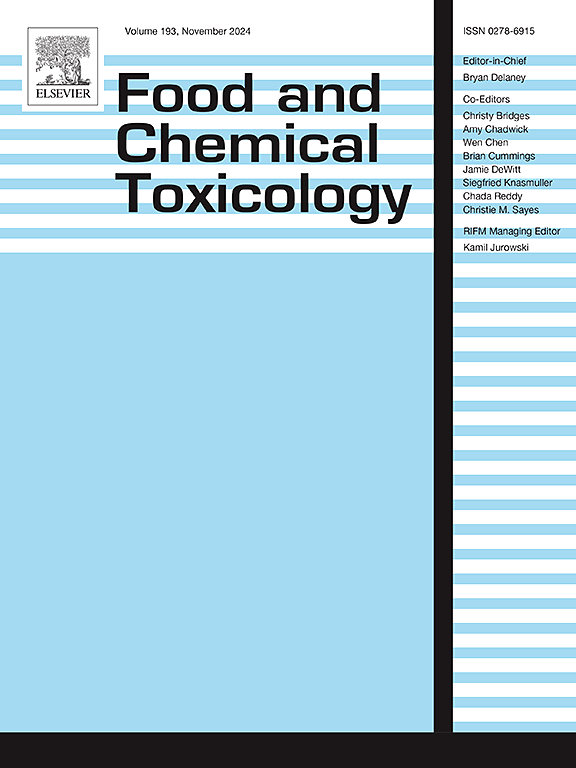Genotoxicity assessment of food-grade titanium dioxide
IF 3.9
3区 医学
Q2 FOOD SCIENCE & TECHNOLOGY
引用次数: 0
Abstract
Food-grade titanium dioxide (E171 in Europe), which contains nanoscale particles (NPs), has been approved and used as a white pigment in various common foods. Concerns are growing over the use of E171 as a safe food additive. The purpose of the present research is to evaluate the genotoxicity of E171 using in vivo and in vitro testing systems. In vitro studies, Chinese hamster lung (V79) fibroblast cells were exposed to E171 at doses of 25, 50, 100, and 200 μg/mL. No gene mutations were observed after 24 h of treatment at any concentration using the hypoxanthine guanine phosphoribosyltransferase (Hprt) gene mutation assay. In vivo study, the healthy Kunming mice and SD rats were exposed to E171 through intragastric administration at doses of 250, 500 and 1000 mg/kg body weight every day for 15 days. Genotoxic potential of E171 was evaluated by micronucleus (MN) and comet assays in accordance with the OECD guideline. However, the results showed that E171 did not increase the frequency of bone marrow micronuclei or induce DNA strand breaks in rat liver cells at the doses used in this experiments. Under the conditions described in this report, E171 was concluded to be negative in these in vivo and in vitro genotoxicity tests. These findings suggest that E171 is not genotoxic, offering valuable data for risk assessment.
食品级二氧化钛的遗传毒性评价
食品级二氧化钛(欧洲称为E171)含有纳米级颗粒(NPs),已被批准用作各种普通食品中的白色色素。人们对使用E171作为安全食品添加剂的担忧日益增加。本研究的目的是通过体内和体外试验系统评估E171的遗传毒性。体外实验中,以25、50、100和200 μg/mL剂量的E171暴露于中国仓鼠肺(V79)成纤维细胞。使用次黄嘌呤鸟嘌呤磷酸核糖基转移酶(Hprt)基因突变试验,在任何浓度处理24小时后均未观察到基因突变。在体内实验中,健康昆明小鼠和SD大鼠分别以250、500和1000 mg/kg体重的剂量,每天灌胃E171,持续15 d。根据OECD指南,采用微核(MN)和彗星试验评价E171的遗传毒性潜力。然而,结果显示,在本实验中使用的剂量下,E171并没有增加大鼠肝细胞骨髓微核的频率或诱导DNA链断裂。在本报告所述的条件下,E171在这些体内和体外遗传毒性试验中均为阴性。这些发现表明E171没有遗传毒性,为风险评估提供了有价值的数据。
本文章由计算机程序翻译,如有差异,请以英文原文为准。
求助全文
约1分钟内获得全文
求助全文
来源期刊

Food and Chemical Toxicology
工程技术-毒理学
CiteScore
10.90
自引率
4.70%
发文量
651
审稿时长
31 days
期刊介绍:
Food and Chemical Toxicology (FCT), an internationally renowned journal, that publishes original research articles and reviews on toxic effects, in animals and humans, of natural or synthetic chemicals occurring in the human environment with particular emphasis on food, drugs, and chemicals, including agricultural and industrial safety, and consumer product safety. Areas such as safety evaluation of novel foods and ingredients, biotechnologically-derived products, and nanomaterials are included in the scope of the journal. FCT also encourages submission of papers on inter-relationships between nutrition and toxicology and on in vitro techniques, particularly those fostering the 3 Rs.
The principal aim of the journal is to publish high impact, scholarly work and to serve as a multidisciplinary forum for research in toxicology. Papers submitted will be judged on the basis of scientific originality and contribution to the field, quality and subject matter. Studies should address at least one of the following:
-Adverse physiological/biochemical, or pathological changes induced by specific defined substances
-New techniques for assessing potential toxicity, including molecular biology
-Mechanisms underlying toxic phenomena
-Toxicological examinations of specific chemicals or consumer products, both those showing adverse effects and those demonstrating safety, that meet current standards of scientific acceptability.
Authors must clearly and briefly identify what novel toxic effect (s) or toxic mechanism (s) of the chemical are being reported and what their significance is in the abstract. Furthermore, sufficient doses should be included in order to provide information on NOAEL/LOAEL values.
 求助内容:
求助内容: 应助结果提醒方式:
应助结果提醒方式:


